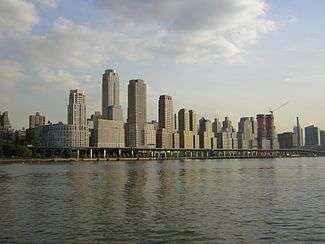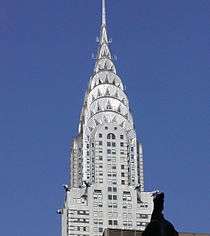Riverside South, Manhattan
|
A view of the complex from the Hudson River | |
| Other name(s) | Trump Place and Riverside Center (for parts) |
|---|---|
| Location | Manhattan, New York City, New York |
| Coordinates | 40°46′41″N 73°59′20″W / 40.778°N 73.989°WCoordinates: 40°46′41″N 73°59′20″W / 40.778°N 73.989°W |
| Status | Most buildings complete; some buildings under construction |
| Groundbreaking | 1997 |
| Constructed | 1997–present |
| Use | Residential |
| Website | ExtellDev |
| Companies | |
| Architect | Daniel Gutman and Paul Willen; Marilyn Taylor and David Childs, SOM |
| Developer | The Trump Organization, Hudson Waterfront Associates, Extell Development Company |
| Owner | Extell Development and The Carlyle Group |
| Planner | Riverside South Planning Corporation |
| Technical details | |
| Cost | US$3 billion |
| Buildings | 19 |
| Size | 8,400,000 square feet (780,000 m2) |
| No. of residents | over 8,000 as of 2012 |
| Proposed | 1989 (other plans proposed since 1962) |
Riverside South is an urban development project in the Lincoln Square neighborhood of the Upper West Side of Manhattan, New York City. It was originated by six civic associations – Municipal Art Society, Natural Resources Defense Council, New Yorkers for Parks, Regional Plan Association, Riverside Park Fund, and Westpride – in partnership with Donald Trump. The largely residential complex, located on the site of a former New York Central Railroad yard, includes Trump Place and Riverside Center. The $3 billion project is on 57 acres (23 ha) of land along the Hudson River between 59th Street and 72nd Street.
Development of the rail yard site generated considerable community opposition. Trump's 1970s-era proposal was opposed and failed to gain traction. In 1982, Lincoln West, a much smaller project, was approved with community support, but the developers failed to obtain financing. Planning for the current project began in the late 1980s. The project was originally designed to include 16 apartment buildings with a maximum of 5,700 residential units, 1,800,000 square feet (170,000 m2) of studio space, 300,000 square feet (30,000 m2) of office space, ancillary retail space, and a 25-acre (10 ha) waterfront park.
Trump sold Riverside South to investors from Hong Kong and China, who began construction in 1997. In 2005, the investors sold the remaining unfinished portions to the Carlyle Group and the Extell Development Company. In November 2016, Trump's name was removed from 3 buildings due to protests against his election as the 45th President of the United States. [1]
60th Street Rail Yard

The land for the development was formerly a rail freight yard owned by the New York Central Railroad, located between 59th and 72nd streets. By 1849 an embankment near West End Avenue, with a span over a tidal lagoon, carried the Hudson River Railroad, later part of New York Central. At the time the current site of Riverside South was still underwater.[3] By 1880, what had been river was transformed by landfill into the New York Central Railroad’s vast 60th Street Yard.[3][4]
New York Central's rail track north of 72nd Street was covered in the 1930s in a Robert Moses project, part of a vast "West Side Improvement" which separated rail lines from surface traffic throughout the length of the West Side.[5][6]:696–698 The Moses project was bigger than Hoover Dam and created the Henry Hudson Parkway. It also created Riverside Park in such a way that the park and road look like they are set on a natural slope.[6]:698–700
Until the 1970s, the rail yard area was generally industrial.[3] The area was home to a printing plant for The New York Times between 1959 and 1975,[7] as well as ABC television studios. At the same time, public housing extended to West End Avenue (across the street from the printing plant and the TV studios), and the Lincoln Towers redevelopment project extended to the rail yard boundary along Freedom Place. In 1962, the railroad proposed a partnership with the Amalgamated Lithographers Union to build a mixed-use development with 5,300 apartments, "Litho City," on a platform over the tracks and on landfill in the Hudson River.[8] Litho City was conceived as the centerpiece of a grandiose "master plan" for the entire Lincoln Square area.[9] In the late 1960s, there were various proposals by the city's Educational Construction Fund for mixed residential and school projects, also partly on landfill.[10]
New York Central merged with the Pennsylvania Railroad to form Penn Central in 1968 as the rail lines were suffering severe financial difficulties that would ultimately lead to the demise of both. (The rail yard was known as the "Penn Yards" even though Penn Central only owned it for a brief period.) The railroad finally went bankrupt in 1971, and the use was discontinued.[10]
Redevelopment plans
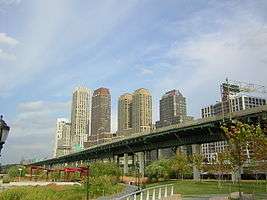
Early planning and Lincoln West
After Penn Central's bankruptcy, real estate developer Donald Trump first optioned the property for $10 million in 1974.[11] His proposal for 12,450 apartments depended on public financing, which never materialized.[12][13] One version had a relocated highway and a pseudo-park.[14]
The Macri Group, an Argentine company, bought the property in partnership with investor Abe Hirschfeld in 1979, and in 1982, for the first time, a redevelopment plan was approved for the site – a 7,300,000-square-foot (680,000 m2), largely residential project named Lincoln West.[15][16] However, the development team was unable to obtain financing, and the project died. Subsequently, in January 1985, Trump bought the rights of the Macri Group for $95 million.[17]
Television City
Trump proposed building a vast complex he called Television City, featuring headquarters for NBC along with television studios. The plan involved 15,500,000 square feet (1,440,000 m2) of residential, retail, office, and studio construction, including 7,600 residential units, a parking garage, a shopping mall, a hotel, and other spaces. The centerpiece of the project, designed by Helmut Jahn, was to be a 150- to 152-story tower, dubbed the "World's Tallest Building."[18][19] However, since the new plan was more than twice the size of the previously approved project, Television City generated fierce opposition.[20] One year later, the project was redesigned by Alexander Cooper and downsized slightly to 14,500,000 square feet (1,350,000 m2), but that failed to satisfy critics.[21] NBC, fearing delays, eventually decided to continue broadcasting from Rockefeller Center.[22] Trump then removed the studio space in favor of open space, added office buildings, and renamed the project Trump City.[23]
Riverside South plan
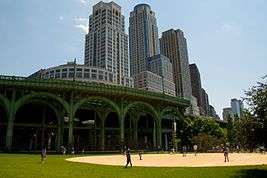
In 1989, six civic organizations proposed an alternative plan devised by Daniel Gutman, an environmental planner, and Paul Willen, an architect.[24] Known as Riverside South, this civic alternative was a largely residential project of 7,300,000 square feet (680,000 m2), the previously approved floor area, based on relocating, and partially burying the West Side Highway to make room for a 23-acre (9.3 ha) expansion of Riverside Park, mirroring the design of Riverside Park further north.[25] To create the park, Trump City's proposed shopping mall would be removed and the elevated West Side Highway would be relocated eastward to grade and buried. A new Riverside Boulevard would curve above the relocated highway, with the park sloping down toward the river.[26] Hobbled by his weak financial position, Trump acquiesced and formed a partnership with his critics, formally the Riverside South Planning Corporation (RSPC).[27]
With a master plan by Skidmore, Owings & Merrill,[13][28] the RSPC compromise project was approved in 1992 without the television studios and office space that Trump had substituted for some of the residential space.[29] The final project size was 6,100,000 square feet (570,000 m2) with 1,800,000 square feet (170,000 m2) of television studios still possible on the two southern blocks. A new Riverside Boulevard would curve above the relocated highway, forming the western edge of the development, with the park sloping down toward he river.[30] Aside from a major new park, the community was promised a significant enhancement to Freedom Place, an existing four-block street behind a Lincoln Towers parking garage, including a monument to replace a plaque commemorating the three civil rights workers who were killed in Mississippi in 1963.[31]
Early on, the project faced opposition for being larger than the previously approved Lincoln West, for increasing traffic on West End Avenue and crowding at the 72nd Street subway station, for including no affordable housing, and because of its association with Trump.[32] Minor objections included potentially blocking all of the westward-facing windows of the Chatsworth, a preexisting apartment building on 72nd Street,[30][33] as well as views from Lincoln Towers. In addition, residents of 71st Street objected to the extension of their street to Riverside Boulevard, thereby making their cul-de-sac into a through street.[30]
The 71st Street problem was easily solved by placing bollards between the existing cul-de-sac and a new mirror-image cul-de-sac on Riverside South property. Most of the major issues were resolved during the approval process. Trump agreed to slightly reduce the overall project size, to partially fund an expansion of the subway station, to a guarantee the affordability of a minimum of 12% of the dwelling units, and that the development would pay for construction and maintenance of the new public park.[13][34] However, some people still strongly opposed the project, with U.S. Representative Jerry Nadler saying that the public park would be a $10,000,000-per-acre ($25,000,000/ha) "private backyard for the people who live in these buildings."[35]
Construction
Start of construction
With Chase Manhattan Bank demanding repayment, Trump gave controlling interest of the project to the consortium of Hong Kong- and China-based investors, Polylinks, in June 1994. The Hong Kong and China consortium Polylinks International Ltd., represented by real estate broker Susan Cara, paid $82 million to Chase to obtain the property, after renegotiating both Trump's business and personal debt down from $300 million. [11] This joint venture finally put in motion the largest private development project in New York City history. Trump remained as the public face of the group, as he has on many other projects, but he lost control.[36] Due to the weak economy, as well as significant community opposition, construction was delayed for several years as lawsuits were resolved and the new investors sought public financing or mortgage insurance.[37][38] The development was delayed repeatedly, with the first building originally slated to start construction in 1995, then in October 1996, and finally in January 1997.[35] With improvement in the development climate, the new investors began construction in 1997, placing the name "Trump Place" in large letters on three buildings. Although Trump ceased his active involvement in the development in 2001, he retained his 30% limited partnership.[39]
West Side Highway relocation
One of the key components of Riverside South is relocating the West Side Highway eastward from a viaduct to a rail-yard-grade-level tunnel between approximately West 70th Street and West 61st Street to facilitate a southward expansion of Riverside Park.[40][41] The current viaduct between 72nd and 59th Streets is the only remaining section of the West Side Elevated Highway that once ran to the southern tip of Manhattan. The highway closed in 1973 when part of the 1920s- and 1930s-era elevated highway collapsed at 14th Street. Below 34th Street, the proposed replacement, an interstate highway in new landfill known as Westway, was defeated, so in 1988, the state settled on an at-grade boulevard up to 57th Street flanked by a new Hudson River Park.[42]
Robert Moses had proposed relocating the highway between 59th and 72nd streets to grade to facilitate an extension of Riverside Park.[43] But the state rejected that proposal because of the presumed negative effect on development opportunities.[44] In 1976, Donald Trump seized on Robert Moses' proposal as a way to enhance his development plans, negating State DOT's objections. But cost was still an issue. While the state owned an easement through the site, neither the state nor the city (nor Trump, at that point) owned the land. Although the City could have acquired the land in the 1970s from Penn Central, the City was also near bankruptcy, and consequently preferred to keep the site in private hands to forestall demands for public expenditure.[45] Instead the state proposed to reconstruct the viaduct through the rail yard site.
Despite city approval in 1992 of the Riverside South plan, which would create a public park with private funds, opponents said that any complementary public funding to bury the road would benefit only the developer and effectively waste the public funds used for the viaduct renovation, which had already begun.[35] Opponents were further upset by the decision to close the West Side Highway northbound entrance and exit ramps at 72nd Street and fought to deny the highway project any funding, thinking that they could thereby scuttle the entire development.[46]
Nevertheless, planning proceeded, albeit in fits and starts. Approved by the Federal Highway Administration in 2001,[47] the highway plan called for relocating the elevated highway to the grade of the rail yard east of the present alignment, constructing supports for Riverside Boulevard in the form of a tunnel enclosing the highway's northbound lanes, with the park beginning above an adjacent tunnel enclosing the southbound lanes and continuing on a slope down to the waterfront. The exit ramp was subsequently closed and, in June 2006, the developer began construction of the northbound tunnel between 61st and 65th Streets.[48][49] However, the tunnel remains unfinished as of 2016.
Opening and new developers
The project was jointly developed by the Trump Organization and Hudson Waterfront Associates, representing the Hong Kong investors.
In 2005, the Hong Kong and China investors sold the project, excluding the finished condominiums, to the Carlyle Group and the Extell Development Company.[50] Contending that the sale for $1.76 billion was little more than half what the property was worth, Trump sued his partners, but lost.[11] After the 2016 presidential election, the current owner of the three Trump Place buildings announced that it would remove Trump's name.[51] Carlyle and Extell then sold the three apartment buildings with rental units to another company called Equity Residential.[52]
In late 2008, Extell proposed a 2,900,000-square-foot (270,000 m2), largely residential project on the southern two blocks (59th to 61st Streets) to complete the development (up from 2,400,000 square feet (220,000 m2) – the 1,800,000 square feet (170,000 m2) of studio space plus 600,000 square feet (56,000 m2) of residential space already approved). The Extell project, known as Riverside Center, was approved by the City Council in 2010.[53]
Components
Buildings
The second phase of Riverside South was completed when the housing market improved. Extell completed three buildings: The Avery (100 Riverside Boulevard), a 32-floor, 274-unit tower; The Rushmore (80 Riverside Boulevard), a group of 43-story towers that share sixteen lower floors and contain a combined 289 units; and The Aldyn (60 Riverside Boulevard), a 40-floor condominium buildings. The Riverside Center buildings were approved in November 2010.[54]
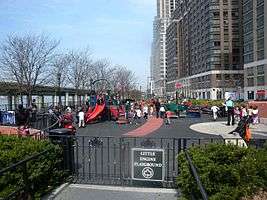
Overall, the project consists of 19 apartment buildings, condominiums, and lease properties. As of 2012, the buildings housed a combined 8,000 people; the area was collectively called "Riverside Boulevard" after its main street, or "The Strip" after its long, narrow shape. Six more towers with a combined 3,000 units, as well as a school, a hotel, retail and restaurant space, and space for a movie theater, had yet to be completed. A 3.4-acre (1.4 ha) park between the buildings was in the planning stages.[52] Most living units in Riverside South are high-end housing, costing at least $2,000 per square foot (22,000/m2).[52] Per-foot real estate prices for Riverside South housing rose 66% from 2004 to 2014, compared with a 43% increase in real estate on the Upper West Side overall.[50] For instance, baseball player Alex Rodriguez bought a 39th-floor Rushmore condominium for $5.5 million in March 2011, then sold it for $8 million in January 2012.[52]
At the same time, 12% to 20% of the units will be designated as affordable, as required by the City Planning Commission approval of the project.[55] However, some buildings in the development, such as One Riverside Park, came under controversy in 2013 for having separate entrances for affordable-housing residents,[56][57] despite the legality of such "poor doors" in mixed-housing buildings.[58]
As of November 2014, the last two Riverside South projects were being completed; these projects were the off-centered, 362-unit One West End condominium building, as well as a glass-and-masonry, 616-unit rental building at 21 West End Avenue. The former was slated to have 116 affordable units, while the latter would have 127 affordable units. These two buildings were being built in conjunction with a 700-seat public school and retail spaces, as well as a possible "European-style food market and restaurant". The project's developers, Extell and Carlyle, were planning to sell the remaining three building lots to a Boston-based company, General Investment and Development Companies.[50] In the same year, Collegiate School announced plans to build a new 10-story campus building at 301 Freedom Place South.[59]
Parks

The new 25-acre (10 ha) Riverside Park South extends Riverside Park.[25] Phase 1, a 7-acre (2.8 ha) section from 72nd to 68th Streets, was opened in April 2001. Pier I at 70th Street, part of the railyard, was rebuilt; it maintains its original length of 795 feet (242 m), but is narrower than originally, at 55 feet (17 m).[60] Phase 2 comprises a waterfront section from 70th Street to 65th Street. Phase 2, opened in June 2003, has two plazas at 66th and 68th Streets, as well as a jagged waterfront. Phase 3, opened in August 2006, stretches from 65th Street to 62nd Street on the waterfront. Phase 4 opened in 2007 along the waterfront from 62nd to 57th Streets.[61] The design of Phases 5, 6, and 7, located between the current and future highway alignments, is tied to the fate of the highway relocation, the timing of which is still uncertain.[62] A new mixed-use bikeway and walkway was also built through the park, linking Hudson River Park with Riverside Park.[63] The park contains site-specific sculptures, railway ruins, gardens, a waterfront promenade, and a walkway.[64] The city plans to expand the park with new basketball courts, bikeways, lawns, picnic areas, and restrooms as part of Phase Five of construction, which would happen between June 2016 and 2018.[65][66]
Portions of the former rail yard, such as the New York Central Railroad 69th Street Transfer Bridge, were incorporated into the new park.[2][61][63] The transfer bridge was listed on the National Register of Historic Places in 2003.[67] Nearly a dozen rail yard ruins, such as a burnt warehouse frame, were ultimately integrated into the park.[63] As a reminder of the location's history, New York Central Railroad logos are engraved onto park benches.[63] A block away, on West End Avenue, a privately-owned park has a remnant of a stone wall, as a remaining part of the embankment that dated to 1847. Construction workers had unearthed the stones during construction in 1994; some stones were salvaged for the new park during the four-day construction hiatus for archaeological excavation.[3]
Other structures
Manhattan Community Board 7 members blamed Trump for the lack of the proposed enhancement and monument at Freedom Place, which was not built. However, the Riverside South Planning Corporation said that the Freedom Place plan was merely a concept for an arts program that was not included into the final project.[31]
As a continuation in spirit of the current Freedom Place, Riverside South created a Freedom Place South running southward from 64th Street to 59th Street, where the historic, full-block IRT Powerhouse and Riverside Center building are located.[68] Adjacent to the Powerhouse, and visible from Freedom Place South, is a new tetrahedron-shaped building at 625 West 57th Street, also known as VIA 57 West.[69]
Name change
After over 600 signed a petition, the owners of Trump Place announced on November 15, 2016 that the buildings would be renamed for their addresses of 140, 160 and 180 Riverside Boulevard. Lettering on the buildings was being removed, and employee uniforms and other items were being replaced. Though Trump had not been connected with the buildings for over ten years, opponents of the use of his name cited his offensive behavior during the U.S. 2016 presidential campaign.[70]
References
- ↑ "Donald Trump's name removed from NYC buildings". 16 November 2016.
- 1 2 "TRANSFER BRIDGE, Riverside Park". Forgotten New York. August 19, 2015. Retrieved May 17, 2016.
- 1 2 3 4 Dunlap, David W. (August 26, 2015). "Park's Stone Wall Is a Vestige of Manhattan's Rail History". New York Times. Retrieved May 17, 2016.
- ↑ City Planning Commission, "Riverside South Final Environmental Impact Statement (FEIS)," October 11, 1992, pp. II-H-3, II-H-18
- ↑ L.H. Robbins, "Transforming the West Side: A Huge Project Marches On," New York Times, June 3, 1934
- 1 2 Robert A.M. Stern, Gregory Gilmartin, Thomas Mellins, "New York 1930," Rizzoli, 1994.
- ↑ "Times Begins Printing At New West Side Plant". New York Times. 1959-07-29. Retrieved 2016-05-17.
- ↑ Litho City (image). home.jps.net. Accessed May 5, 2016.
- ↑ "Litho City Master Plan (aerial view)" (PDF). chpcny.org. Retrieved May 11, 2016.
- 1 2 New York City Department of City Planning, "Lincoln Square and its Waterfront," NYC DCP 76-27, October 1976.
- 1 2 3 Bagli, Charles V. (2005-06-01). "Trump Group Selling West Side Parcel for $1.8 Billion". The New York Times. Retrieved 2016-05-17.
- ↑ 1975 Trump Proposal (image). home.jps.net. Accessed May 5, 2016.
- 1 2 3 Vitullo-Martin, Julia (2004-01-19). "The West Side Rethinks Donald Trump's Riverside South". home.jps.net. Retrieved 2016-05-17.
- ↑ Carter B. Horsley, "Park Extension Sought by Trump," The New York Times, May 9, 1976.
- ↑ Lincoln West (image). home.jps.net. Accessed May 5, 2016.
- ↑ Joyce Purnick, "Estimate Board Gives Approval to Lincoln West," The New York Times, September 17, 1982.
- ↑ Alan Oser, "Huge Projects that Shape the Landscape of the City," The New York Times, May 10, 1987.
- ↑ Television City (image). home.jps.net. Accessed May 5, 2016.
- ↑ Paul Goldberger, "Trump Announces Plan to Construct World's Tallest Building," New York Times, November 19, 1985
- ↑ Thomas J. Leuck, "Celebrities Open Wallets to Fight Trump's Project," New York Times, September 30, 1987
- ↑ Paul Goldberger, "Television City Project: Tempered but Still Big," The New York Times, October 24, 1986.
- ↑ Leuck, Thomas J. "NBC Will Not Move to Television City," The New York Times, October 31, 1987. "The developer plans the world's tallest building – 150 floors of offices and apartments – and other structures that would include 7,600 apartments, a large shopping mall, a parking garage and a hotel."
- ↑ Trump City (image). home.jps.net. Accessed May 5, 2016.
- ↑ Paul Goldberger "Another Chance for a Prime Piece of Real Estate," The New York Times, July 1, 1990.
- 1 2 The Civic Alternative (GIF image) accompanying Paul Goldberger, "Another Chance for a Prime Piece of Real Estate," The New York Times, July 1, 1990. Accessed May 5, 2016.
- ↑ Riverside South, as proposed
- ↑ Todd S. Purdum, "Trump Revises Project Plan for West Side", New York Times, March 6, 1991.
- ↑ SOM's Riverside South Model (image) from Architecture & Urbanism (Japan), Sept. 1993 Special issue. Accessed May 5, 2016.
- ↑ Steven Prokesch, Panel Clears Trump Plan On West Side," New York Times, October 27, 1992
- 1 2 3 "RIVERSIDE SOUTH, Manhattan". forgotten-ny.com. Retrieved May 11, 2016.
- 1 2 Lee, Denny (October 13, 2002). "NEIGHBORHOOD REPORT: UPPER WEST SIDE; Names Fade From a Street, But Not From Memories". The New York Times. ISSN 0362-4331. Retrieved May 11, 2016.
- ↑ Bruce Weber, "Debate on Trump's West Side Proposal," New York Times, July 22, 1992
- ↑ Gray, Christopher (December 13, 1992). "Streetscapes: The Chatsworth; Riverside South's Threat to a 1904 Apartment Tower". The New York Times. ISSN 0362-4331. Retrieved May 11, 2016.
- ↑ Alan Finder, "Trump Yields to Demands on Housing," New York Times, October 22, 1992.
- 1 2 3 Dunlap, David W. "In Trump Revision, Highway Stays and Park Goes," The New York Times (February 25, 1997)
- ↑ Timothy L. O'Brien (January 27, 2016). "How Trump Bungled the Deal of a Lifetime". BloombergView.
- ↑ Robert Lipsyte, "COPING; Talking About What You're Thinking About," New York Times, September 11, 1994
- ↑ Thomas J. Lueck, "Trump Project Loses Bid for U.S. Mortgage Insurance," New York Times, July 24, 1998
- ↑ "P A U L W I L L E N A R C H I T E C T".
- ↑ "Map of Riverside Park extension". Google Maps.
- ↑ Plan of underground highway (image), landarchs.com. Accessed May 17, 2016.
- ↑ "MILLER'S CROSSING: THE WEST SIDE ELEVATED HIGHWAY". Forgotten New York. June 2001. Retrieved May 17, 2016.
- ↑ Robert Moses' Proposal, 1975 (image). home.jps.net. Accessed May 5, 2016.
- ↑ State of New York, "Westway Final Environmental Impact Statement (FEIS)," Section 6, pp. 7, 8, 1975, 1977
- ↑ Glenn Fowler, "A River Park West of Lincoln Sq. Endorsed by City Planning Study," The New York Times, November 30, 1976.
- ↑ Richard Perez-Pena, "Highway Plan for West Side Appears Dead," The New York Times, July 26, 1995.
- ↑ "FHWA Record of Decision" (PDF).. home.jps.net. Accessed May 5, 2016.
- ↑ James Barron, "The Surprise in This Box? A Highway, Some Assembly Required," The New York Times, June 23, 2006.
- ↑ "Street View of highway and northbound tunnel entrance". Google Maps.
- 1 2 3 Hughes, C. J. (November 14, 2014). "Residential Towers Finish Project on Far West Side". The New York Times. Retrieved May 17, 2016.
- ↑ Charles Bagli, "Trump Won the Election but 3 Manhattan Buildings Will Lose His Name," New York Times, November 11, 2016
- 1 2 3 4 Gregor, Alison (February 24, 2012). "All This Neighborhood Needs Is a Name". The New York Times. Retrieved May 17, 2016.
- ↑ Riverside Center and other Extell Buildings (image). home.jps.net. Accessed May 5, 2016.
- ↑ "Riverside Boulevard". NYC Blog Estate. February 27, 2012. Retrieved 2016-05-17.
- ↑ Spinola, Steven (December 23, 2014). "Riverside South provides pathway to housing New Yorkers". Real Estate Weekly. Retrieved May 15, 2016.
In addition to this, one of the Riverside South Planning Commission’s requirements for the development is that 20 percent of it must be affordable housing.
- ↑ Briquelet, Kate (August 18, 2013). "Upper West Side condo has separate entrances for rich and poor". New York Post. Retrieved August 18, 2013.
- ↑ Zimmerman, Neetzan (August 18, 2013). "Outrage Over Separate Doors for Rich and Poor in Manhattan High-Rise". Gawker Media. Retrieved August 18, 2013.
- ↑ Smith-Mack, Mitzie (May 1, 2015). "Thousands of applicants are willing to accept NYC "Poor Door" building". Philadelphia: Ballard Spahr LLP.
- ↑ Bockmann, Rich (December 29, 2014). "Collegiate School files plans for Riverside South building". The Real Deal New York. Retrieved May 17, 2016.
- ↑ "Pier I". Riverside Park NYC. February 8, 2013. Retrieved May 17, 2016.
- 1 2 Park history, riversideparknyc.org. Retrieved August 26, 2014.
- ↑ "The Surprise in This Box? A Highway, Some Assembly Required", New York Times, June 23, 2006.
- 1 2 3 4 "WEST SIDE FREIGHT YARDS". Forgotten New York. March 2001. Retrieved May 17, 2016.
- ↑ "Exploring the Upper West Side's Riverside Park South". Curbed NY. 2012-09-06. Retrieved 2016-05-17.
- ↑ "Riverside South Park Expansion Planned". NYC Blog Estate. 2016-04-28. Retrieved 2016-05-17.
- ↑ "Riverside Park South : NYC Parks". New York City Department of Parks & Recreation. Retrieved 2016-05-17.
- ↑ "National Register of Historic Places Listings July 11, 2003". nps.gov. Retrieved June 24, 2015.
- ↑ Gorshin, Maria (2012-04-11). "New York's 'Temple of Power': the 59th Street Powerstation". Untapped Cities. Retrieved 2016-05-17.
- ↑ Capps, Kriston (May 1, 2015). "The Great Pyramids of Manhattan". The Atlantic. Retrieved May 17, 2016.
- ↑ Hawkins, Derek (November 16, 2016). "Donald Trump's name to be dropped from 3 NYC buildings after residents petition for removal". Winston-Salem Journal. Retrieved November 16, 2016.
External links
| Wikimedia Commons has media related to: |
- Extell's Riverside South website
- Paul Willen's history of Riverside South
- The Waterfront Center Honor Award, 2011
